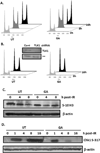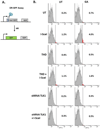Tousled kinase activator, gallic acid, promotes homologous recombinational repair and suppresses radiation cytotoxicity in salivary gland cells
- PMID: 26855419
- PMCID: PMC5257199
- DOI: 10.1016/j.freeradbiomed.2015.12.029
Tousled kinase activator, gallic acid, promotes homologous recombinational repair and suppresses radiation cytotoxicity in salivary gland cells
Abstract
Accidental or medical radiation exposure of the salivary glands can gravely impact oral health. Previous studies have shown the importance of Tousled-like kinase 1 (TLK1) and its alternate start variant TLK1B in cell survival against genotoxic stresses. Through a high-throughput library screening of natural compounds, the phenolic phytochemical, gallic acid (GA), was identified as a modulator of TLK1/1B. This small molecule possesses anti-oxidant and free radical scavenging properties, but in this study, we report that in vitro it promotes survival of human salivary acinar cells, NS-SV-AC, through repair of ionizing radiation damage. Irradiated cells treated with GA show improved clonogenic survival compared to untreated controls. And, analyses of DNA repair kinetics by alkaline single-cell gel electrophoresis and γ-H2AX foci immunofluorescence indicate rapid resolution of DNA breaks in drug-treated cells. Study of DR-GFP transgene repair indicates GA facilitates homologous recombinational repair to establish a functional GFP gene. In contrast, inactivation of TLK1 or its shRNA knockdown suppressed resolution of radiation-induced DNA tails in NS-SV-AC, and homology directed repair in DR-GFP cells. Consistent with our results in culture, animals treated with GA after exposure to fractionated radiation showed better preservation of salivary function compared to saline-treated animals. Our results suggest that GA-mediated transient modulation of TLK1 activity promotes DNA repair and suppresses radiation cytoxicity in salivary gland cells.
Keywords: Acinar; DNA repair; Gallic acid; Homologous recombination; Radiation; Salivary; Tousled; Xerostomia.
Published by Elsevier Inc.
Conflict of interest statement
There is no conflict of interest to disclose.
Figures






Similar articles
-
DNA damage response and repair data with pharmacological modulators of Tousled.Data Brief. 2016 Mar 30;7:1073-7. doi: 10.1016/j.dib.2016.03.075. eCollection 2016 Jun. Data Brief. 2016. PMID: 27408917 Free PMC article.
-
Adenoviral delivery of Tousled kinase for the protection of salivary glands against ionizing radiation damage.Gene Ther. 2011 Mar;18(3):275-82. doi: 10.1038/gt.2010.142. Epub 2010 Nov 4. Gene Ther. 2011. PMID: 21048794
-
TAT-mediated delivery of Tousled protein to salivary glands protects against radiation-induced hypofunction.Int J Radiat Oncol Biol Phys. 2012 Sep 1;84(1):257-65. doi: 10.1016/j.ijrobp.2011.10.064. Epub 2012 Jan 26. Int J Radiat Oncol Biol Phys. 2012. PMID: 22285666
-
Preserving salivary gland physiology against genotoxic damage - the Tousled way.Oral Dis. 2018 Nov;24(8):1390-1398. doi: 10.1111/odi.12836. Epub 2018 May 2. Oral Dis. 2018. PMID: 29383801 Free PMC article. Review.
-
Current ideas to reduce or salvage radiation damage to salivary glands.Oral Dis. 2015 Jan;21(1):e1-10. doi: 10.1111/odi.12222. Epub 2014 Feb 28. Oral Dis. 2015. PMID: 24581290 Review.
Cited by
-
Untousling the Role of Tousled-like Kinase 1 in DNA Damage Repair.Int J Mol Sci. 2023 Aug 29;24(17):13369. doi: 10.3390/ijms241713369. Int J Mol Sci. 2023. PMID: 37686173 Free PMC article. Review.
-
Research progress on antitumor effects of sea buckthorn, a traditional Chinese medicine homologous to food and medicine.Front Nutr. 2024 Jul 9;11:1430768. doi: 10.3389/fnut.2024.1430768. eCollection 2024. Front Nutr. 2024. PMID: 39045282 Free PMC article.
-
Protective Effect and Mechanism of Action of Rosmarinic Acid on Radiation-Induced Parotid Gland Injury in Rats.Dose Response. 2020 Feb 20;18(1):1559325820907782. doi: 10.1177/1559325820907782. eCollection 2020 Jan-Mar. Dose Response. 2020. PMID: 32127788 Free PMC article.
-
Desensitizing Mitochondrial Permeability Transition by ERK-Cyclophilin D Axis Contributes to the Neuroprotective Effect of Gallic Acid against Cerebral Ischemia/Reperfusion Injury.Front Pharmacol. 2017 Apr 6;8:184. doi: 10.3389/fphar.2017.00184. eCollection 2017. Front Pharmacol. 2017. PMID: 28428752 Free PMC article.
-
Efficacy of Manuka honey oral rinse in treatment of xerostomia among elderly patients: a randomized controlled trial.BMC Oral Health. 2025 May 23;25(1):777. doi: 10.1186/s12903-025-06125-9. BMC Oral Health. 2025. PMID: 40410721 Free PMC article. Clinical Trial.
References
-
- Li Y, DeFatta R, Anthony C, Sunavala G, De Benedetti A. A translationally regulated Tousled kinase phosphorylates histone H3 and confers radioresistance when overexpressed. Oncogene. 2001;20:726–738. - PubMed
-
- Silljé HH, Nigg EA. Identification of human Asf1 chromatin assembly factors as substrates of Tousled-like kinases. Curr Biol. 2001;11:1068–1073. - PubMed
-
- Sunavala-Dossabhoy G, De Benedetti A. Tousled homolog, TLK1, binds and phosphorylates Rad9; TLK1 acts as a molecular chaperone in DNA repair. DNA Repair (Amst) 2009;8:87–102. - PubMed
Publication types
MeSH terms
Substances
Grants and funding
LinkOut - more resources
Full Text Sources
Other Literature Sources
Miscellaneous

